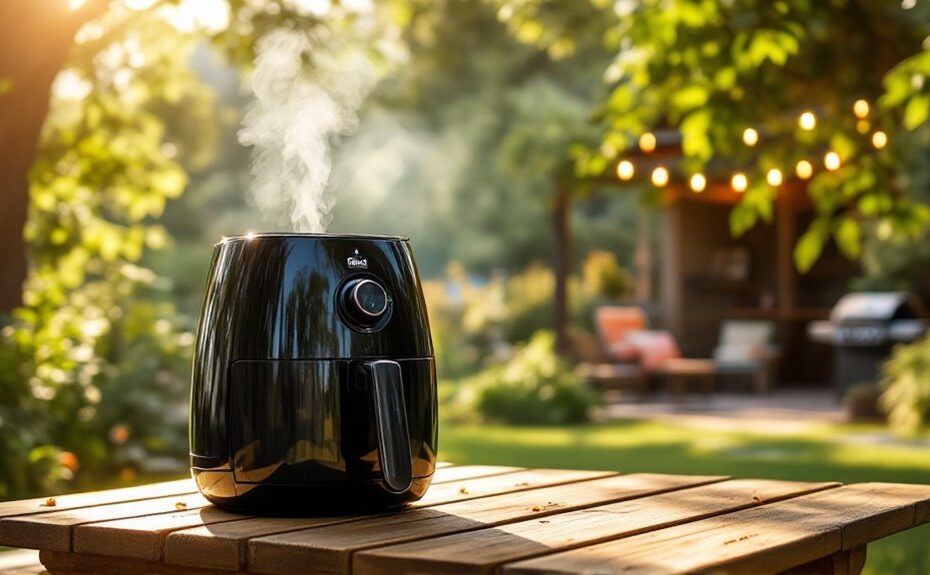You might wonder if your air fryer can handle the great outdoors, but the answer isn't as straightforward as you'd think. While it's tempting to bring it along for a backyard cookout or camping trip, you'll need to evaluate factors like power sources, weather conditions, and safety precautions. What happens if it rains, or if you don't have the right setup? The risks and rewards of outdoor air frying might surprise you, and there's more to it than just plugging it in outside. What you don't know could make all the difference—so let's explore the details.
Key Takeaways
- Air fryers can be used outdoors with proper power sources like portable generators or solar setups, ensuring wattage and voltage compatibility.
- Outdoor use requires a stable, flat surface, proper ventilation, and protection from weather conditions like rain, wind, or extreme temperatures.
- Use heavy-duty, outdoor-rated extension cords and avoid overloading circuits to prevent electrical hazards or damage to the air fryer.
- Regular cleaning, weatherproofing, and storage in a dry, shaded area are essential to maintain performance and safety for outdoor air fryer use.
- Check manufacturer guidelines for outdoor compatibility and ensure the air fryer is certified for safe operation in outdoor environments.
Understanding Air Fryer Power Requirements
Before using an air fryer outdoors, it's vital to comprehend its power needs, as most models depend on a standard electrical outlet. Start by conducting a power consumption analysis to determine the wattage your air fryer requires. Most units operate between 1,200 and 1,800 watts, which can strain circuits if not properly managed. Next, perform a voltage compatibility check to confirm the outdoor power source matches the air fryer's specifications, typically 120V in the U.S. Mismatched voltage can damage the appliance or pose safety risks. Always verify the manufacturer's guidelines for specific power requirements. Understanding these technical details guarantees your air fryer operates efficiently and safely outdoors, minimizing the risk of electrical issues or appliance failure.
Outdoor Power Source Options
When using an air fryer outdoors, you'll need to verify your power source meets the appliance's requirements. Most air fryers require a standard 120V outlet, so make sure your outdoor setup can deliver this consistently. Portable generators are a common solution, but you must check their wattage output and generator compatibility to avoid overloading the circuit. Look for generators with at least 1500-1800 watts to handle the air fryer's peak power draw. Solar power options can also work if you have a reliable inverter and sufficient battery capacity to sustain the appliance's energy demands. Always confirm the inverter's wattage rating matches or exceeds the air fryer's requirements. Avoid using extension cords unless they're rated for the appliance's power needs to prevent overheating or voltage drops.
Weather Conditions and Air Fryer Safety
While air fryers can be used outdoors, weather conditions substantially impact their safety and performance. Extreme temperatures, whether hot or cold, can affect the appliance's efficiency. High heat may cause the air fryer to overheat, while freezing conditions can slow its heating elements. Humidity effects are equally critical; moisture can damage electrical components or create safety hazards. Always make sure the air fryer is placed in a dry, shaded area to minimize temperature impact and humidity exposure. Avoid using it during rain or high winds, as these conditions increase the risk of electrical malfunctions or accidents. Check the manufacturer's guidelines for operating temperature ranges and humidity limits. By monitoring weather conditions, you can safely use your air fryer outdoors without compromising its functionality or your safety.
Portable Air Fryers for Outdoor Use
Portable air fryers designed for outdoor use offer a convenient solution for cooking in varied environments, provided they meet specific safety and performance standards. When selecting a model, prioritize a compact, lightweight portable design that guarantees easy transport and setup. Look for units with battery operation or compatibility with portable power sources, as these eliminate reliance on fixed electrical outlets. Confirm the device is rated for outdoor conditions, including resistance to moisture and temperature fluctuations. Verify that the air fryer's construction materials are durable and non-combustible to minimize fire risks. Always check for certifications indicating compliance with safety standards. Avoid using indoor-only models outdoors, as they may lack the necessary protections. Proper ventilation and stable placement are critical to prevent overheating or accidents during operation.
Setting Up Your Air Fryer Outside
To set up your air fryer outdoors, make sure you've chosen a flat, stable surface that's free from flammable materials and sheltered from direct exposure to wind or rain. Follow these outdoor setup tips to guarantee safety and efficiency. Select a location with proper ventilation to prevent overheating, and avoid placing it near walls or furniture that could block airflow. Use a grounded outdoor outlet or a heavy-duty extension cord rated for outdoor use. Check the cord for damage before plugging in. Keep the air fryer away from water sources, such as pools or sprinklers, to avoid electrical hazards. Location selection advice includes positioning it under a covered patio or awning to protect it from sudden weather changes. Always monitor the appliance while in use.
Potential Risks of Outdoor Air Fryer Use
Using an air fryer outdoors exposes it to weather-related hazards, such as moisture or extreme temperatures, which can damage its components. You must verify the electrical setup is safe, avoiding exposed cords or overloaded outlets to prevent shocks or short circuits. Additionally, placing the air fryer near flammable materials or unstable surfaces increases fire risks, requiring careful placement and monitoring.
Weather Exposure Hazards
While air fryers are designed for indoor use, exposing them to outdoor weather conditions can pose significant risks. Temperature fluctuations, such as extreme heat or cold, can damage internal components, affecting performance and longevity. Moisture protection is another critical concern; rain, humidity, or dew can seep into the appliance, leading to electrical malfunctions or corrosion. Even in covered outdoor areas, condensation or sudden weather changes can compromise the air fryer's functionality. Additionally, exposure to wind or dust may clog vents, reducing efficiency and potentially causing overheating. Always guarantee the appliance is shielded from direct sunlight, as prolonged UV exposure can degrade materials. Using an air fryer outdoors without proper safeguards increases the likelihood of weather-related damage, making it essential to prioritize its protection.
Electrical Safety Concerns
When operating an air fryer outdoors, you must consider the potential electrical hazards that arise from improper setup or environmental exposure. Make sure the power cord is rated for outdoor use and free from damage, as frayed or exposed wires can lead to short circuits or shocks. Avoid running the cord across high-traffic areas or near water sources to prevent tripping or electrocution. Use a grounded outlet with a weatherproof cover to protect against moisture and debris. Never overload the circuit by plugging in additional appliances, as this can cause overheating or power failure. Always inspect the cord and connections before use, and disconnect the air fryer immediately if you notice any irregularities. Prioritize power cord safety to minimize electrical hazards during outdoor operation.
Fire Risk Factors
Outdoor air fryer use introduces fire risk factors that demand careful attention, particularly due to the appliance's high heat output and potential exposure to flammable materials. When operating an air fryer outdoors, you must place it on a stable, non-flammable surface, away from dry grass, leaves, or wooden decks. Always monitor the appliance while in use, as overheating or grease buildup can ignite. Follow fire safety tips, such as keeping a fire extinguisher nearby and ensuring proper ventilation to prevent flare-ups. Avoid using extension cords, which can overheat and pose additional outdoor cooking hazards. Never leave the air fryer unattended, and allow it to cool completely before storing. By addressing these risks, you minimize the chance of fire incidents during outdoor use.
Cleaning and Maintenance Tips for Outdoor Cooking
Establish a regular cleaning routine to remove grease and food residue from your air fryer after each outdoor use. Store the appliance in a dry, sheltered area to prevent moisture damage and guarantee it's protected from dust and debris. Consider weatherproofing your equipment with covers or enclosures to safeguard it from outdoor elements.
Regular Cleaning Routine
To maintain your air fryer's performance and longevity while using it outdoors, you'll need to follow a consistent cleaning routine. Establish a cleaning frequency based on usage—daily cleaning is ideal if you use it regularly. After each use, unplug the unit and let it cool completely. Wipe the exterior with a damp cloth to remove dust or debris. Remove the basket and tray, then wash them with warm, soapy water to eliminate grease and food residue. Avoid abrasive scrubbers to prevent scratching non-stick surfaces. Check the heating element for buildup and gently clean it with a soft brush. Incorporate these steps into your maintenance schedule to prevent malfunctions and guarantee peak operation. Always dry components thoroughly before reassembling to avoid moisture damage.
Proper Storage Practices
After cleaning your air fryer, proper storage is key to protecting it from outdoor elements and ensuring it remains in good condition. Store it in a dry, shaded area to maintain storage temperature control and prevent overheating or freezing, which can damage internal components. Use moisture prevention strategies by ensuring the appliance is completely dry before storage and placing it in a sealed container or cover to shield it from humidity. Avoid leaving it exposed to rain or dew, as moisture can lead to rust or electrical issues. If possible, store it indoors when not in use to minimize exposure to temperature fluctuations and environmental contaminants. Always disconnect the power cord and store it separately to prevent wear or damage.
Weatherproofing Your Equipment
When using an air fryer outdoors, weatherproofing your equipment is essential to protect it from environmental damage. Invest in weatherproofing materials like silicone sealants or waterproof tapes to shield sensitive components from moisture. Use protective cover solutions, such as custom-fit covers or heavy-duty tarps, to guard against rain, dust, and UV exposure. Make sure the cover is securely fastened to prevent wind from dislodging it. Avoid placing the air fryer directly on damp surfaces; instead, use a raised, stable platform. Regularly inspect the cover for wear and replace it if damaged. Store the air fryer in a dry, shaded area when not in use to minimize exposure to extreme temperatures. Proper weatherproofing extends the lifespan of your equipment and guarantees consistent performance.
Alternatives to Using an Air Fryer Outdoors
If you're unable to use an air fryer outdoors due to safety concerns or lack of access to power, several alternatives can achieve similar results. For indoor alternatives, consider using a convection oven, which circulates hot air to crisp food similarly to an air fryer. A toaster oven with a convection setting also works well for smaller portions. Alternatively, you can use a stovetop grill pan or a countertop grill to achieve a crispy texture. For outdoor grilling, a gas or charcoal grill with a lid can mimic air frying by creating a convection-like environment. Use indirect heat and a drip pan to avoid flare-ups while cooking. These methods provide flexibility and safety while delivering comparable results to an air fryer.
Best Practices for Outdoor Air Fryer Cooking
When using an air fryer outdoors, make sure your cooking area is weatherproofed to protect against moisture and debris. Maintain proper ventilation to prevent overheating and avoid placing the appliance near flammable materials. Always use a grounded, outdoor-rated power source to minimize electrical hazards.
Weatherproofing Your Cooking Area
To guarantee your outdoor air fryer operates safely and efficiently, you must weatherproof your cooking area. Start by selecting a location that supports sheltered cooking, such as under a patio, gazebo, or awning. This shields the appliance from direct rain, wind, and debris. Use waterproof covers designed for air fryers to protect the unit when not in use, ensuring they fit snugly to prevent moisture ingress. Avoid placing the air fryer on uneven or damp surfaces, as this can compromise stability and safety. If you're cooking in an open area, consider a portable canopy or umbrella for additional protection. Always check the manufacturer's guidelines for outdoor use to confirm compatibility with weatherproofing measures. Proper preparation minimizes risks and extends the lifespan of your appliance.
Ensuring Proper Ventilation
While outdoor air fryer cooking offers convenience, guaranteeing proper ventilation is critical to prevent overheating and maintain safe operation. Air fryers generate heat and require adequate ventilation requirements to dissipate it effectively. Always place your air fryer in an open, well-ventilated area to avoid heat buildup. Avoid enclosing it in tight spaces or under overhangs, as this restricts airflow considerations and increases the risk of malfunction. Position the appliance on a stable, heat-resistant surface, guaranteeing at least 6 inches of clearance on all sides for ideal airflow. Check that the exhaust vents remain unobstructed during use to prevent overheating. If cooking under a patio or canopy, confirm sufficient overhead clearance to allow heat to escape. Proper ventilation guarantees efficient performance and reduces safety hazards.
Safe Power Source Setup
Proper ventilation guarantees your air fryer operates safely outdoors, but equally important is setting up a reliable power source. Always use a heavy-duty, outdoor-rated extension cord with sufficient wattage capacity to handle your air fryer's power requirements. Make sure the cord is in good condition, free of frays or damage, and rated for at least 15 amps. Avoid daisy-chaining multiple cords, as this increases fire risks. If using a generator, verify its compatibility with your air fryer's wattage and confirm it's placed on a stable, dry surface away from moisture. Check the generator's output capacity to prevent overloading, which can damage both the generator and the appliance. Prioritize grounding and surge protection to safeguard your equipment and maintain a safe cooking environment.
Legal and Safety Regulations to Consider
Before using an air fryer outdoors, you must check local regulations and safety guidelines, as some areas may prohibit outdoor use of electrical appliances due to fire hazards or zoning restrictions. Make sure your air fryer meets local regulations compliance and adheres to safety certification standards, such as UL or CE markings, which confirm it's tested for safe operation. Avoid using uncertified or modified appliances, as they may pose risks like electrical fires or malfunctions. Additionally, verify if your outdoor space complies with fire codes, especially in dry or high-risk areas. Always follow the manufacturer's instructions for outdoor use, if permitted, and avoid exposing the appliance to moisture or extreme weather conditions. Non-compliance could result in fines or safety hazards, so prioritize adherence to all applicable rules.
Disclosure: As an Amazon Associate, I earn from qualifying purchases.



